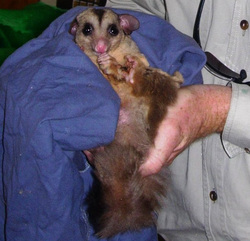
He was called Anniken, named by one of the international students who had paid their own way to Australia to help DERM monitor these highly endangered gliders in the wake of the giant cyclone.
As Annikin looked with what appeared to be real interest from the top of the bag held by QPWS Senior Conservation Officer Mark Parsons who is in charge of the on-the-ground work being carried out, it was impossible not to be moved.
Tiny and beautiful with clean, soft fur and huge eyes, the little glider – a wild animal – trustingly accepted the smiles and touches of those surrounding him.
Mark returned him to the darkness and safety of the bag and the meeting settled down once again to discuss the serious business of strategies for conserving him and his kind in a future which may be desperately challenging.
This was the fourth time Anniken had been caught as part of this ongoing process of trapping gliders, a procedure undertaken to help give some idea of the surviving numbers, to monitor their health and to discover where they hunted and nested.
After checking them, the gliders are freed where they had been trapped.
Many nights over the months of the project had revealed no gliders, then one morning Annikin was there in the trap. Later, a female was also trapped, and it was hoped they were a breeding pair.
Anniken was healthy, and in the time since he was first trapped in May when he weighed 350grams, he had gained 62 grams and was, Mark pronounced “in really good nick”. He was estimated to be about four years old.
However, not all months are good for glider food production. October is a particularly barren time and this year, following the cyclone, is full of question marks for food production.
Even in their very restricted range, which runs along the coastal lowlands approximately from Tully Heads to about 40kms south of Ingham, mahogany gliders are rare. Before Cyclone Yasi it was estimated the total world population was about 1500 individuals.

This means restoration of damaged areas and maintaining connectivity, improving it where necessary. Currently, much of the connectivity between the main areas where gliders were known to be has been damaged, and trees are still dying.
On the positive side, Dr Winter said, much of the undergrowth threatening to overtake the gliders’ woodland habitat has been opened up, making it easier for them to move around. Having said that, there is less for them to feed on.
But Cyclone Yasi has yielded much real information as well as given food for thought.
One of the main necessities is that although, hopefully, there will never be another such destructive event, preparedness in case is still essential.
The most dangerous time for wildlife, apart from during the cyclone itself, is in the first days following it, when creatures are still shocked and food is scarce. For this reason, setting up feeding stations near known glider habitats and maintaining them so the gliders are aware of them and can access them in a disaster is one idea being considered.
Much too can be learned from study of these areas, with occasional trapping and camera surveillance.
The public can also do much, Dr Winter said, simply by reporting possible sightings, making sure injured animals get to carers, and maintaining habitat by planting glider trees. A list of these is on the flyer drawn up last year by WPSQ.
“Another way of helping maintain this rare and endangered species is by reducing the use of barbed wire. Many gliders have died cruel, protracted deaths hooked on barbed wire, which is so hard to see at night when they are moving through their territory,” he said.

“Even simply using plain wire for the top strand will make a huge difference which can, literally, be the difference between life and death.”


